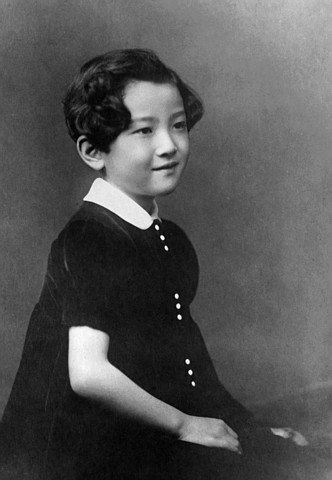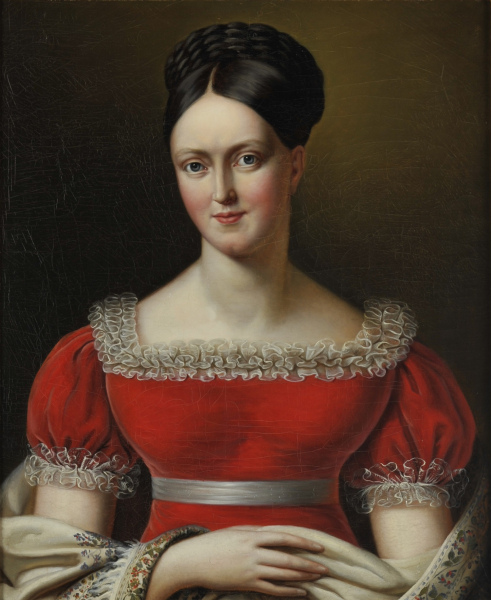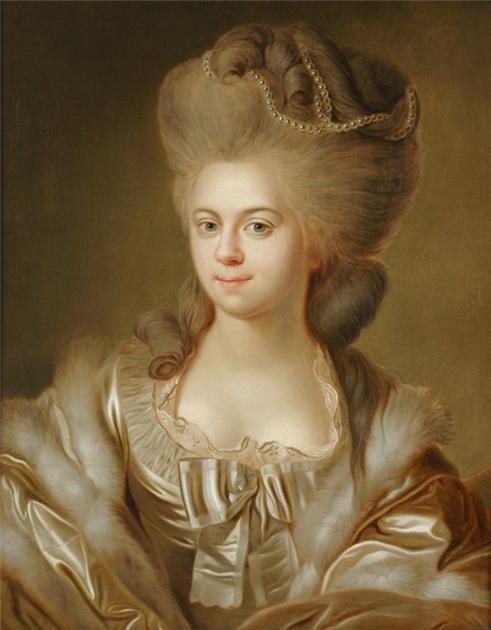by Susan Flantzer © Unofficial Royalty 2018

Akihito and Michiko on their wedding day with Emperor Shōwa and Empress Kōjun; Credit – Wikipedia
Emperor Akihito of Japan, at the time Crown Prince of Japan, and Michiko Shōda were married on April 10, 1959, at the Kashiko-dokoro, the Shinto shrine of Amaterasu, the Sun Goddess, on the grounds of the Imperial Palace in Tokyo, Japan.
Emperor Akihito’s Background

Akihito and his mother; Credit – Wikipedia
Emperor Akihito of Japan was born on December 23, 1933, at the Tokyo Imperial Palace. He was the fifth of the seven children and the eldest son of Emperor Hirohito and Princess Nagako of Kuni. Akihito was the heir-apparent to the Chrysanthemum Throne from birth. He had one younger brother and five younger sisters.
Akihito, titled Prince Tsugu, was initially educated by tutors at the Imperial Palace before completing his elementary and secondary education at The Gakushūin (Peers School) in Tokyo. During the American Occupation of Japan, following World War II, he was tutored in English and Western culture, along with some of his siblings. Akihito later briefly attended Gakushūin University, studying Political Science, but did not obtain a degree. On November 10, 1952, he was formally invested as Crown Prince in a ceremony held at the Imperial Palace.
Unofficial Royalty: Emperor Akihito of Japan
Michiko Shōda’s Background

Michiko in 1940; Credit – Wikipedia
Michiko Shōda was born on October 30, 1934, in Tokyo. She was the eldest daughter and the second of the four children of Hidesaburō Shōda, president, and later honorary chairman of Nisshin Flour Milling Company, and Fumiko Soejima. She had one older brother, one younger brother, and a younger sister. Michiko was raised in Tokyo, where she began her education, studying both a traditional and Western curriculum, learning to speak English and play the piano. During World War II, Michiko’s family left Tokyo because of the American bombings. The family returned in 1946, and Michiko completed her primary and secondary education. She graduated from high school in 1953. She then attended the University of the Sacred Heart in Tokyo, earning a Bachelor’s Degree in English Literature. She also attended Harvard University in the United States and Oxford University in England.
Unofficial Royalty: Empress Michiko of Japan
The Engagement
Embed from Getty Images
Crown Prince Akihito and Michiko Shōda first met on a tennis court on August 19, 1956, at Karuizawa, a summer resort. Akihito and Michiko were in opposing mixed pairs in a tournament. Michiko and her partner won the match. Under the strict Imperial Household protocol, the couple could not meet alone during their courtship. They arranged their meetings at tennis courts among other acquaintances. As the relationship blossomed, Akihito called Michiko on the phone, sometimes as many as ten times a day.
The engagement was announced on November 27, 1958. The Imperial Council, which consists of ten palace and civil officials headed by Prime Minister Nobuskue Kishi, unanimously approved the marriage. Michiko was the first commoner to marry into the Imperial Family, and that did cause some controversy.
Embed from Getty Images
On January 14, 1959, the engagement ceremony (Nosai-no-Gi) was held. The Crown Prince’s chamberlain arrived at the Shōda home with the traditional, plainly wrapped gifts: two enormous fish (tai or red sea bream), six bottles of sake, and five bolts of silk. The fish were laid out head to head, at a slight angle to each other, forming the lucky symbol of the number eight, which is supposed to bring prosperity to the couple. Two simple but elegant unpainted wood boxes carried the other presents, the six bottles of sake, and the five bolts of silk which would be made into kimonos for the future princess. At the three shrines at the Imperial Palace, Akihito, wearing classic Japanese court dress, reported his engagement to his ancestors.
The Wedding Attire
Embed from Getty Images
On the morning of the wedding, Michiko’s body was purified in an ancient ritual. Next, court ladies dressed her in the formal bridal attire, the juni-hitoe, which means a twelve-layered garment. Michiko’s hair was arranged in the puffed classic style with long, artificial strands added down her back. The dressing of her hair and arranging the 30-pound silk kimono with a white silk brocade train took over two hours.
Akihito wore a flowing robe of bright orange, representing the rising sun, which by tradition only a crown prince can wear. Both the bride and groom’s costumes dated back to the Heian Era (794-1185).
The Wedding Ceremony

The Three Palace Sanctuaries at the Imperial Palace in Tokyo; Credit – Imperial Household Agency
Crown Prince Akihito of Japan and Michiko Shōda were married on April 10, 1959, at the Kashiko-dokoro, the Shinto shrine of Amaterasu, the Sun Goddess and mythological ancestress of the Imperial Family, part of the Three Palace Sanctuaries on the grounds of the Imperial Palace in Tokyo, Japan. Television coverage provided millions of Japanese their first-ever glimpse of the Three Palace Sanctuaries. 1,070 guests were invited, including Imperial Family members, the bride’s relatives, government officials, lawmakers, judges, and industrial leaders. Mrs. Elizabeth Gray Vining from Philadelphia, Pennsylvania in the United States, who had been Crown Prince Akihito’s tutor, was the only non-Japanese guest. The groom’s parents, Emperor Hirohito and Empress Nagako, were not among the guests. They stayed in their imperial sitting room a few hundred yards from the shrine, and waited until mid-afternoon when the newlyweds visited them to inform them of the morning marriage. Neither the guests nor the television viewers saw any part of the wedding ceremony. The guests stood in the Imperial Garden and only saw the bride and groom, accompanied by Shinto ritualists, chamberlains, and ladies-in-waiting, as they slowly walked down a long wooden porch.
At 10 AM, Akihito and Michiko were married in the Kekkon-no-gi ceremony before an altar enshrining the Sun Goddess, the guardian of the Imperial Family. The wedding ceremony took only eleven minutes and was held in the presence of only the palace’s chief Shinto ritualist, a chamberlain bearing the centuries-old sword representing the crown prince, a court lady, and an unwed priestess symbolizing purity.
In the inner sanctuary of the shrine, the couple knelt on rice straw mats. The bride was on the left, with the chief ritualist standing on the left. A white silk curtain separated the inner sanctuary from the outer-most part of the shrine, which opens into the Imperial Garden. The chief ritualist gave the bride and groom a sakaki twig, a sacred symbol. Holding the twigs, Akihito and Michiko bowed to the inner sanctuary four times. Although the palace’s chief ritualist, an important figure in the Shinto religion, was present inside the shrine, the Crown Prince was the only person who did any speaking. Akihito read from a 1,200-year-old text, addressing the Sun Goddess: “This is the occasion of my wedding, and we have come before you at the House of Wisdom…We pray for your protection in the future.”
Then the chief ritualist waved a sacred dogwood sprig, and the couple sipped sake from thimble-sized cups and bowed to each other. After the ceremony, Akihito and Michiko went to the Kōrei-den, the Ancestral Spirits Sanctuary, another of the Three Palace Sanctuaries, where the departed spirits of the Imperial Family are enshrined one year after their death, to report the wedding to Akihito’s imperial ancestors. The couple emerged from the shrine for another solemn procession down the wooden porch as husband and wife.
Embed from Getty Images
The bride and the groom were separated until their meeting with the Emperor and Empress at 2:00 PM to report their marriage. For that meeting, they changed into Western evening dress – Akihito wearing white tie and tails and Michiko wearing a low-cut white dress with gold thread, a white stole, and a diamond tiara. They then met with Emperor Hirohito and Empress Nagako at the Imperial Palace in a ceremony known as Choken-no-Gi (First Audience Ceremony). In the ancient ceremony, Akihito, Michiko, the Emperor, and the Empress were given chopsticks but no food and pantomimed the act of eating together. The newlyweds then drove through the streets of Tokyo, filled with cheering people, to their home. During the ride through the streets of Tokyo, a 19-year-old man threw a rock at the carriage and tried to climb into the carriage. He was immediately restrained by police.
Embed from Getty Images
The couple participated in another ritual, the Kyutyu-Shukuen-no-Gi (Celebratory Banquet) in which rice cakes are offered along with prayers for the birth of a healthy boy. The Kyutyu-Shukuen-no-Gi (Celebratory Banquet) occurred for three nights. Each night, the couple received pounded rice cakes known as mochi. They ate some rice cakes and buried the rest in the Imperial Garden, while the priests chanted prayers for the Crown Princess to have children.
This article is the intellectual property of Unofficial Royalty and is NOT TO BE COPIED, EDITED, OR POSTED IN ANY FORM ON ANOTHER WEBSITE under any circumstances. It is permissible to use a link that directs to Unofficial Royalty.
Works Cited
- Nytimes.com. (1958). Akihito to Mark Betrothal. [online] Available at: http://www.nytimes.com/1958/12/30/archives/akihito-to-mark-betrothal.html [Accessed 30 Oct. 2017].
- Timesmachine.nytimes.com.(1958). Akihito’s Troth Held Nearer. [online] Available at: https://timesmachine.nytimes.com/timesmachine/1958/11/22/83426888.html?pageNumber=23 [Accessed 30 Oct. 2017].
- Trumbull, R.(1958). AKIHITO WILL WED TOKYO COMMONER; High Council Backs Prince in His Choice of Bride AKIHITO WILL WED TOKYO COMMONER. [online] Nytimes.com. Available at: http://www.nytimes.com/1958/11/27/archives/akihito-will-wed-tokyo-commoner-high-council-backs-prince-in-his.html [Accessed 30 Oct. 2017].
- Trumbull, R.(1959). Akihito Betrothal Made Official With Simplified Rites in Tokyo; Prince Sends Presents to Miss Shoda, Then Visits Shrines in Palace — Rigid Protocols to Be Eased for Wedding. [online] Nytimes.com. Available at: http://www.nytimes.com/1959/01/15/archives/akihito-betrothal-made-official-with-simplified-rites-in-tokyo.html?_r=0 [Accessed 30 Oct. 2017].
- Trumbull, R. (1958). BRIDE OF AKIHITO TO BE NAMED SOON; Betrothal of Crown Prince to Commoner Is Expected in Tokyo Tomorrow. [online] Nytimes.com. Available at: http://www.nytimes.com/1958/11/26/archives/bride-of-akihito-to-be-named-soon-betrothal-of-crown-prince-to.html [Accessed 30 Oct. 2017].
- Trumbull, R. (1959). Akihito Weds a Commoner in Colorful Japanese Rites; Prince Akihito Weds Commoner in Tokyo Ceremony. [online] Nytimes.com. Available at: http://www.nytimes.com/1959/04/10/archives/akihito-weds-a-commoner-in-colorful-japanese-rites-prince-akihito.html [Accessed 30 Oct. 2017].
- Trumbull, R. (1959). Modern Lovers And Ancient Rituals; Akihito’s choice of a commoner as his bride flouts tradition; but other traditions remain.. [online] Nytimes.com. Available at: http://www.nytimes.com/1959/02/22/archives/modern-lovers-and-ancient-rituals-akihitos-choice-of-a-commoner-as.html [Accessed 30 Oct. 2017].
- Trumbull, R. (1959). Youth Hurls a Rock at Akihito’s Bridal Carriage; The Royal Wedding Is the Climax to a Day of Pageantry in Tokyo TOSSED ROCK MARS AKIHITO WEDDING. [online] Nytimes.com. Available at: http://www.nytimes.com/1959/04/11/archives/youth-hurls-a-rock-at-akihitos-bridal-carriage-the-royal-wedding-is.html [Accessed 30 Oct. 2017].
- Unofficial Royalty. (2017). Wedding of Crown Prince Naruhito of Japan and Masako Owada. [online] Available at: https://www.unofficialroyalty.com/wedding-of-crown-prince-naruhito-of-japan-and-masako-owada/ [Accessed 30 Oct. 2017].
































